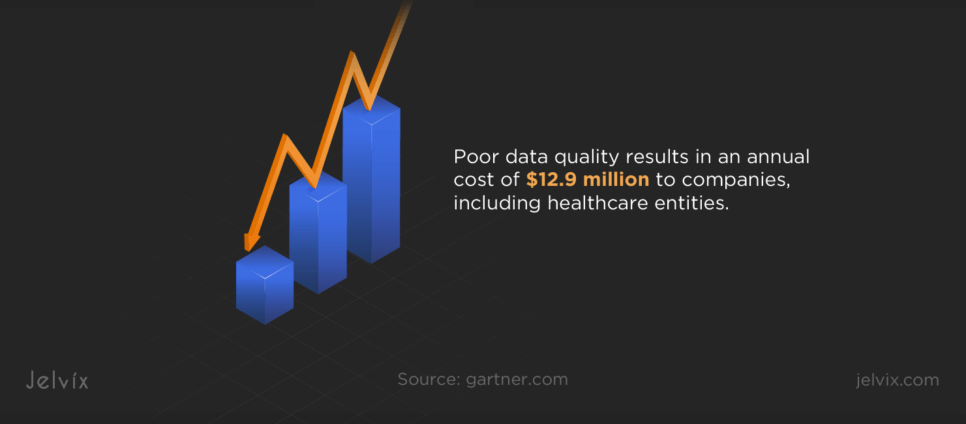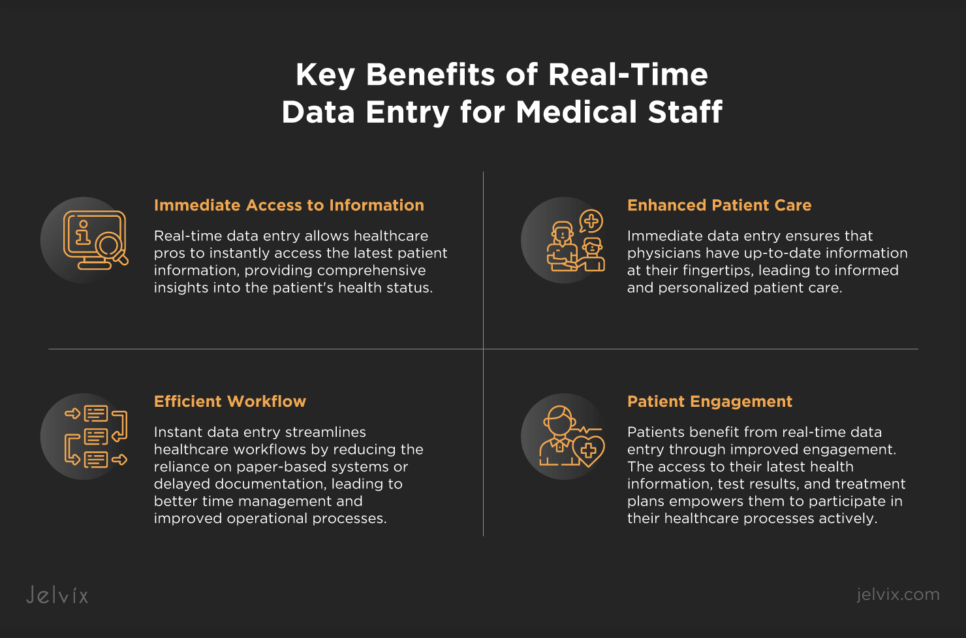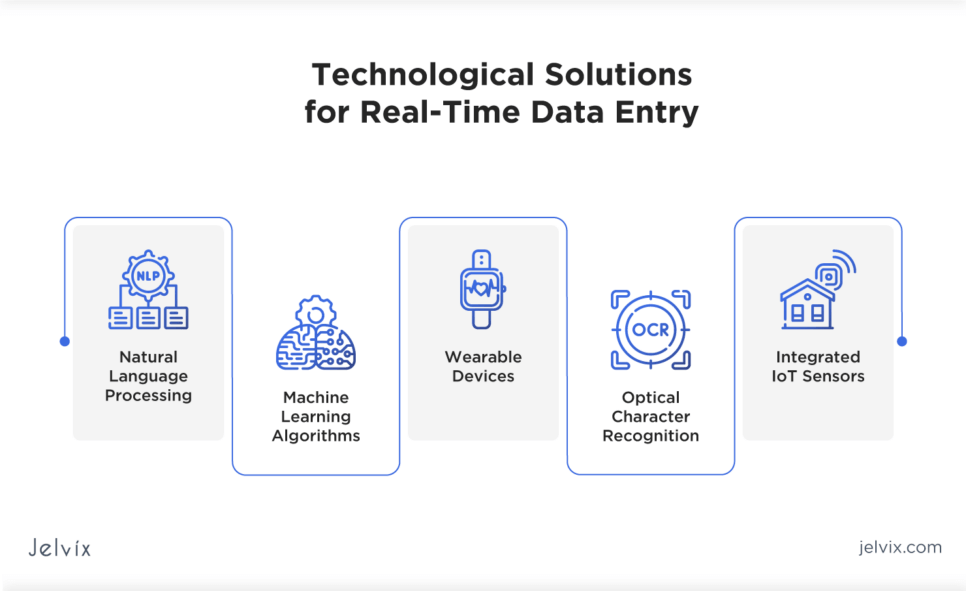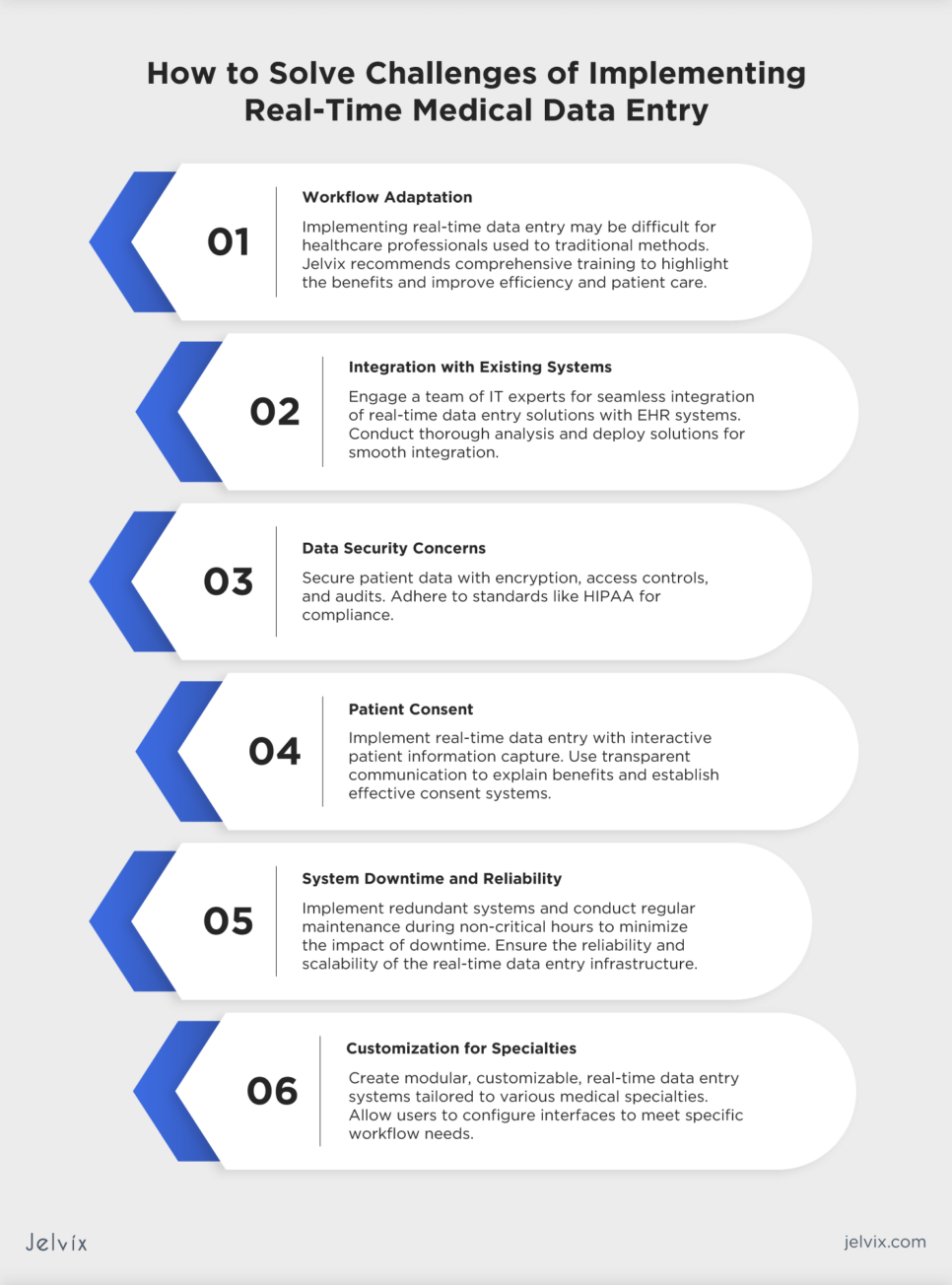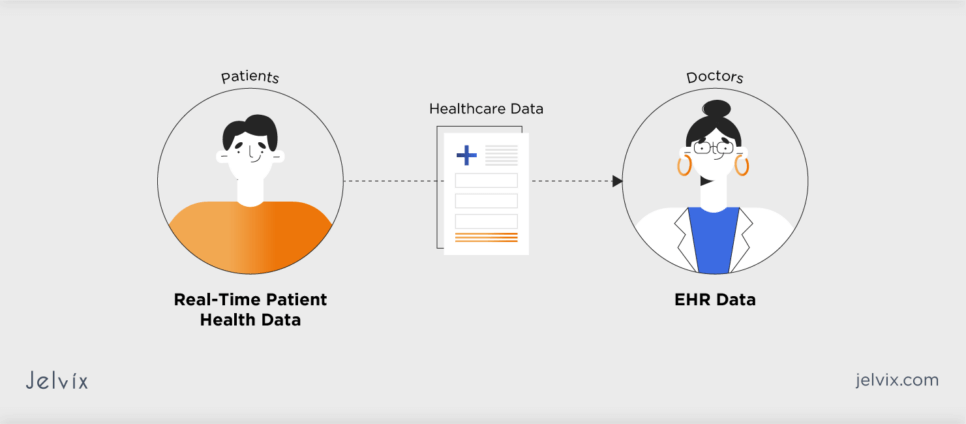Rapid technology development has changed the way patient data should be handled. Gartner reports that poor data quality results in an annual cost of $12.9 million to companies, including healthcare entities.
For medical organizations, the key challenge lies in not just maintaining the accuracy of patient records but also ensuring their availability and accessibility across various locations and platforms. This emphasizes the need to develop solutions that both facilitate real-time data entry and ensure secure and efficient access to patient data.
If you’re a tech provider seeking to develop solutions that support widespread and safe access to patient data or a medical service provider aiming to reduce physician burnout, this article is for you. Keep reading to find out how to implement real-time data entry tech seamlessly to enhance patient care, improve data accuracy, and support clinical decision-making.
What Medical Records Data Entry Is
Real-time data entry in Electronic Health Records (EHR) refers to the immediate and direct input of patient information into electronic systems as it occurs during a healthcare encounter. It ensures that the most current and relevant patient data is readily available to physicians.
Impact of Real-Time Data Entry on Healthcare Outcomes
Real-time patient data entry ensures that healthcare professionals have instant access to the most up-to-date information allowing for quick interventions when necessary. Its significance extends to improved collaboration among healthcare teams, increased accuracy in diagnosis and treatment, and enhanced patient engagement.
Key benefits of real-time data entry include:
- Immediate access to information: real-time data entry allows healthcare pros to instantly access the latest patient information, providing comprehensive insights into the patient’s health status;
- Enhanced patient care: immediate data entry ensures that physicians have up-to-date information at their fingertips, leading to informed and personalized patient care;
- Efficient workflow: instant data entry streamlines healthcare workflows by reducing the reliance on paper-based systems or delayed documentation, leading to better time management and improved operational processes;
- Patient engagement: patients benefit from real-time data entry through improved engagement. The access to their latest health information, test results, and treatment plans empowers them to participate in their healthcare processes actively.
The Role of EHR in Modern Healthcare
EHRs are widely adopted across various healthcare facilities. In the U.S., over 88% of office-based physicians use EHR/EMR systems for efficient medical data management.
Since EHRs serve as a digital repository of patient health information, they consolidate data from various sources, offering a comprehensive and centralized view of a patient’s medical history. Real-time data entry in EMR enhances patient care by providing immediate access to critical information and promoting collaboration among healthcare professionals.
Enhancing Patient Safety and Care Quality
Real-time data entry solutions help enhance patient safety and care quality by entering and updating patient information promptly in EHR systems. As a result, physicians get immediate access to the most accurate and current information.
Facilitating Immediate Clinical Decision-Making
Immediate access to up-to-date patient information empowers healthcare professionals to make timely and well-informed clinical decisions. Real-time data entry ensures clinicians have the latest details on a patient’s medical history and ongoing treatments, facilitating swift responses and personalized care plans.
Reducing the Chance of Manual Data Input Errors
Real-time data entry significantly improves the accuracy of medical records by minimizing human error in manual data entry. By automating the data input process, the chances of typos, omissions, or inaccuracies are greatly reduced. This precision ensures the integrity of patient data and contributes to safer and more effective healthcare practices.
Challenges of Implementing Real-Time Medical Data Entry
While the advantages of real-time data entry are significant, its implementation comes with a set of challenges. Understanding and overcoming these will help maximize the benefits of real-time data entry solutions for patient safety and quality care.
Integration with Existing Systems
Seamless integration of real-time data entry functionality with existing EHR systems can be complex and time-consuming. Engage experienced IT professionals to conduct a thorough analysis of existing systems and deploy solutions that facilitate seamless integration of real-time data entry capabilities.
Workflow Adaptation
Introducing real-time data entry may require adjustments to established workflows, leading to potential resistance from healthcare professionals accustomed to traditional documentation methods. The Jelvix team recommends conducting comprehensive training programs to educate healthcare pros on the benefits of real-time data entry, emphasizing its positive impact on efficiency and patient care.
Data Security Concerns
Ensuring the security and privacy of real-time entered data poses a challenge, as healthcare organizations need robust measures to protect sensitive patient information from unauthorized access or cyber threats. Implement robust encryption protocols, access controls, and regular security audits to safeguard patient data. Adhere to industry standards and regulations, such as HIPAA, to ensure compliance.
Patient Consent
Implementing real-time data entry may involve capturing patient information more interactively. Develop transparent communication strategies to inform patients about the benefits of real-time data entry. Implement systems for obtaining and documenting patient consent effectively.
System Downtime and Reliability
Unplanned system downtime can disrupt real-time data entry processes, affecting patient care and workflow efficiency. Implement redundant systems and backup mechanisms to minimize downtime impact. Conduct regular maintenance during non-critical hours, and ensure the reliability and scalability of the real-time data entry infrastructure.
Customization for Specialties
Different medical specialties may require specific data entry fields and features, making customization a challenge. Develop modular and customizable real-time data entry systems that can be tailored to the specific needs of different medical specialties. Allow users to configure interfaces based on their workflow requirements.
Technical and Infrastructure Challenges
Technical and infrastructure challenges in real-time data entry for EHRs involve addressing complex issues to ensure seamless and efficient integration into healthcare systems. Addressing these challenges requires a comprehensive approach that involves collaboration between healthcare IT professionals, vendors, and regulatory bodies:
- Data interoperability: ensuring interoperability between different systems and devices is a significant challenge. Integrating diverse technologies and data sources requires standardized formats and protocols to facilitate smooth communication;
- System integration complexity: healthcare organizations often use a variety of systems and applications. Integrating real-time data entry solutions with existing EHRs requires careful planning and execution to avoid disruptions and data inconsistencies.
- Infrastructure scalability: as healthcare data continues to grow, the infrastructure must scale to accommodate the increasing volume of real-time data. Ensuring that the underlying infrastructure is scalable and can handle the demands of real-time entry is crucial for long-term sustainability;
- Data quality: maintaining the accuracy and quality of real-time entered data is essential. Implementing measures for data validation, error detection, and correction is necessary to ensure the integrity of the information stored in EHR systems;
- Regulatory compliance: ensuring compliance with regulatory requirements adds a layer of complexity to the technical and infrastructure considerations, requiring continuous monitoring and adaptation to evolving standards.
Training and Adoption Among Healthcare Professionals
The adoption of new technologies, including real-time data entry systems, requires comprehensive training among healthcare professionals. Resistance to change and unfamiliarity with the technology can slow down the integration. Consider implementing targeted training programs to help healthcare pros with real-time adaptation to data entry tools. Provide ongoing support and resources to ensure a smooth transition.
Balancing Speed with Accuracy
Achieving a balance between the speed of data entry and maintaining high accuracy is a persistent challenge. Rapid data entry may compromise the precision and quality of information. Consider employing intuitive user interfaces and design systems that prioritize both speed and accuracy. Implement validation checks and automated prompts to reduce errors during real-time data interactions.
Technological Solutions for Real-Time Data Entry
Tech solutions leverage real-time data entry by providing streamlined and efficient mechanisms for capturing, processing, and integrating information into EHRs. Mobile applications, voice recognition, wearables, and other technologies enable healthcare professionals to input, retrieve, and analyze patient information promptly and correctly:
- Natural Language Processing: NLP can interpret and extract relevant information from unstructured clinical notes, supporting real-time data entry by converting free-text documentation into structured data;
- Machine Learning algorithms: ML algorithms can analyze complex data sets to provide predictive analytics, assist in diagnosis, and facilitate treatment planning, reducing the burden of data analysis on healthcare professionals;
- Wearable devices: wearables with health tracking capabilities contribute to real-time data collection, capturing vital signs and patient activity levels for comprehensive health monitoring;
- Optical Character Recognition: OCR technology can convert various types of documents, such as scanned paper records or digital photographs, into editable and searchable data, reducing errors in data transcription;
- Integrated IoT sensors: the Internet of Things sensors embedded in medical equipment enable automated data entry, providing real-time updates on patient metrics.
If you are unsure about what technology suits your needs and ways of implementing it, you’re welcome to get in touch with our managers. They will be happy to provide you with advice on healthcare software development tailored to your specific needs.
Integration of Mobile Devices and Tablets for Medical Data Entry
Mobile devices, including smartphones and tablets, can leverage error-free data entry. Apps often include built-in validation tools that check for common errors. What’s more, the intuitive interfaces of mobile apps make it easier for healthcare pros to input data accurately. Well-designed interfaces can guide users through data entry processes, reducing the chance of errors.
Mobile devices provide physicians with the flexibility to access EHR systems anytime. This portability is especially beneficial during patient visits, allowing immediate data capture without reliance on stationary computers or paper-based records.
Natural Language Processing
As the Jelvix team noted earlier in this article, NLP can be truly beneficial for real-time data entry. It empowers EHR systems to understand and interpret human language in a way that mimics human comprehension. In the context of real-time data entry, NLP enables the system to extract relevant information from spoken or typed narratives. This advanced capability allows physicians to input information more naturally and conversationally, improving the overall usability of the EHRs.
AI and Machine Learning in Data Capture and Analysis
It is projected that artificial intelligence (AI) in healthcare will allow physicians to spend almost 20% more of their time on patients due to reduced administrative burden.
AI-driven tools automate the data capture process by extracting relevant information from various sources. This includes structured data from forms, unstructured data from clinical notes, and data from medical images. Automated data capture reduces the workload on healthcare professionals, streamlining the collection of comprehensive patient information.
What’s more, AI algorithms can perform real-time quality assurance checks on captured data. They identify inconsistencies, errors, or missing information, providing feedback to doctors for correction.
Machine Learning (ML) algorithms analyze historical healthcare data to identify patterns and trends. In data capture, predictive analytics can anticipate the types of information that need to be recorded based on patient history, symptoms, or treatment plans.
Real-Time Data Entry Efficiency: Success Stories
The real-world case studies highlight the impact of real-time data entry on healthcare organizations, showcasing improved efficiency, better decision-making, and enhanced patient care outcomes.
Calderdale and Huddersfield NHS Foundation Trust
CHFT based in the UK implemented voice recognition tech to leverage real-time data entry. Clinicians utilized voice recognition to input clinical notes, reducing the time spent on paperwork. In six months, over 40,000 minutes of text were entered using voice recognition, saving an estimated 150,000 minutes compared to traditional typing methods. The initiative aimed to enhance efficiency, minimize record variances, and alleviate staff frustration related to heavy paperwork.
Mayo Clinic
Mayo Clinic has implemented voice technology to enhance patient care and engagement. Partnering with conversational AI provider Orbita, Mayo Clinic expanded its voice-enabled content to Google Assistant and introduced an AI-powered voice chatbot that enables faster access to medical information using voice input.
Cleveland Clinic
Cleveland Clinic implemented a chatbot for healthcare to provide a screening tool for people experiencing illnesses. By asking a series of questions, the chatbot assesses symptoms and risk factors, guiding users to appropriate care recommendations. The chatbot encourages users to seek medical care if necessary, emphasizing telemedicine options over in-person visits. The goal is to explore voice technology’s potential as a diagnostic tool and to enhance patient adherence to post-discharge instructions.
Best Practices and Guidelines for Real-Time Data Entry Implementation
Implementation of real-time data entry tech in EHRs requires adherence to key strategies to ensure optimal results. Following proven guidelines and best strategies promotes a successful and effective implementation, contributing to improved patient care and streamlined healthcare workflows.
Standardization of Data Input
Establish standardized protocols for entering and formatting data. Consistent data input formats enhance accuracy and simplify data retrieval, promoting interoperability across different healthcare systems.
Integration with Workflows
Seamlessly integrate real-time data entry into existing healthcare workflows. Minimize disruptions by aligning data entry processes with the natural flow of healthcare activities, ensuring user acceptance and adoption.
Data Validation Mechanisms
Manual data entry is error-prone. However, AI-based recognition algorithms help to find errors in data and correct the input. Consider implementing robust data validation mechanisms to ensure the accuracy and completeness of entered information. Incorporate validation rules and error-checking features to identify and correct errors in real time.
Interoperability Considerations
Adhere to interoperability standards, such as FHIR and HL7, to promote seamless data exchange. Ensure compatibility with other healthcare systems and devices. Optimize data exchange by making real-time entry systems interoperable, enabling seamless communication across diverse healthcare platforms.
Discover actionable strategies to enhance EHR workflow efficiency and streamline healthcare operations.
User Training and Engagement
To ensure effective integration of real-time data entry into EHR, healthcare organizations should implement strategic training and staff encouragement measures. Develop comprehensive training initiatives tailored to specific roles, conduct hands-on workshops and simulations, craft role-specific training modules, and establish feedback loops for seamless adoption.
User-Centric Design
Prioritize a user-centric design that aligns with the natural workflows of healthcare professionals. A user-friendly interface enhances adoption rates, minimizes training requirements, and reduces the chance of frustration related to adopting new tools.
Security and Privacy Measures
Implement robust security protocols to safeguard patient information. Protect patient privacy and comply with healthcare data security standards to build trust among doctors and patients.
Continuous Monitoring and Improvement
Establish regular monitoring and feedback mechanisms. Continuous evaluation and improvement based on user feedback and system performance ensure ongoing optimization and user satisfaction.
Scalability for Future Requirements
Design the system with scalability in mind to accommodate future data needs. Anticipate and plan for increased data volumes and evolving healthcare requirements to avoid system limitations over time.
Legal and Regulatory Considerations
Compliance with laws such as the Health Insurance Portability and Accountability Act (HIPAA) and other relevant healthcare regulations ensures the confidentiality, security, and privacy of patient data. Organizations must establish robust data governance policies, conduct regular audits, and stay informed about evolving legal frameworks to maintain compliance and uphold the integrity of real-time data entry practices in EHR systems.
Data Privacy and Security in Real-Time Systems
Data privacy and security in real-time systems are essential considerations to safeguard sensitive information. Robust measures, such as the ones listed below, can be implemented to ensure the safety of patient data:
- Encryption: real-time systems employ advanced encryption techniques to encode data during transmission and storage. This cryptographic protection helps prevent unauthorized access and maintains the privacy of patient information;
- Access controls: role-based access controls restrict system access based on the user’s role or responsibilities. This ensures that only authorized personnel can view or modify specific types of data, contributing to a secure and privacy-focused environment;
- Audit trails: comprehensive audit trails capture and log activities within the system, documenting who accessed what data and when. This feature aids in monitoring user actions, identifying potential security breaches, and ensuring accountability;
- Authentication mechanisms: multi-factor authentication adds an extra layer of security by requiring users to provide multiple forms of identification before accessing the system. This minimizes the risk of unauthorized access, enhancing overall data security.
Predictions for the Real-Time Data Entry in EHR
Healthcare experts predict that AI adoption in healthcare will significantly impact data entry. Research indicates that 90% of US physicians plan to use AI for data entry and other purposes.
Overall, predictions for the future of real-time data entry in EHRs point toward several key trends and advancements:
- Integration with wearable devices: patients using wearables will be able to contribute to their health data in real time, providing valuable insights to healthcare providers for more personalized care;
- Advancements in voice recognition: improved accuracy and natural language processing capabilities will allow healthcare professionals to input information seamlessly using voice commands;
- Enhanced AI for data validation: advanced AI algorithms will analyze incoming data in real time, identifying discrepancies or potential errors and prompting immediate corrective actions;
- Augmented and Virtual Reality: healthcare professionals might leverage AR and VR for immersive data visualization and interactive input methods, optimizing data accuracy.
- How Jelvix Contributes to Correct Data Entry in Healthcare
As a tech partner who takes care of custom software development and integration of new solutions into existing EHR systems, the Jelvix team understands the importance of real-time data entry tools.
We developed a telehealth solution with a remote patient monitoring module that ensures 24/7 access to up-to-date patient data. Our system enables clinicians to access and update patient records instantly, ensuring that the information stays current and accurate.
If you aim to leverage healthcare operations through real-time data entry solutions, you’re welcome to address our managers for a personalized consultation. They will be happy to answer all your questions about solutions we may offer based on your specific needs.
Optimize your healthcare operations with custom EHR solutions tailored to your needs.


